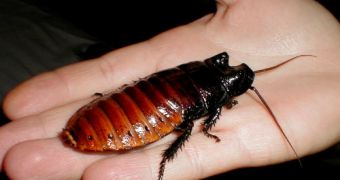1.There's nothing more disgusting among the insects than cockroaches. Of the world's 4,000 species, only 30 species live in our household. The house infesting species vary from the 3 cm (1.2 in) long American cockroach, Periplaneta americana (really nasty seeing it around the house), to the 1.5 cm (0.6 in) long German cockroach, Blattella germanica. But tropical forest cockroaches can be really huge insects, up to 9 cm (3.6 in) long! (what a relief they do not prefer our houses...). And these are pygmies compared to cockroaches that lived 250 million years ago, before the dinosaurs: 50 cm (1 ft 8 in) long!
2.Cockroaches are really persistent and so hardy that researchers found they were the only organisms that could survive in an area after atomic experiments, except for scorpions!
3.A 2007 Japanese research found that cockroaches have memory enabling them to form Pavlovian reflexes (learning)! The researchers taught cockroaches to salivate in response to neutral stimuli like the Russian scientist Pavlov did a century ago with dogs. Forming conditioned reflexes requires memory and learning capacity, abilities linked to intelligence, and this kind of salivating response was previously proven only in humans, apes, dogs and other mammals.
In their tests, the Japanese researchers exposed the cockroaches to an odor whenever they fed them with a sugary solution. When they exposed the cockroaches to the odor alone, after several repetitions, the insects still drooled. Cockroaches fed on sugary solutions without the odor did not display the salivary conditioned reflex when exposed to the smell.
4.Try to catch a cockroach and you will see it is almost impossible. On their flanks cockroaches have small hairs that detect the slightest movement of the air caused by approaching animals as well as their direction. This, combined with an extremely rapid nervous system, enables the cockroaches to have reflexes and reactions measured in hundredths of seconds when running. High speed cameras revealed they can run with 1 m (3.3 ft)/s (it's like you moving with 140 m (470 ft)/s) and can change direction 25 times per second! No animal has such well developed orientation behavior and can change direction with such a frequency!
5.Even if termites are called "white ants", they have nothing to do with the real ants (which are in fact a type of wasps). Despite their extremely complicated social structure and behavior inside their enormous colonies and the fact that they are able to build magnificent clay nests, they are in fact related to the detested cockroaches. DNA proved it! The most primitive termites are Mastotermes in northwestern Australia and close islands. They make nests in dead wood and resemble cockroaches. Their sperm has 100 flagella, a record in the animal world!
6.A recently developed toy designed by Jose Halloy, a social ecologist at the Free University of Brussels in Belgium could get us rid of cockroaches. The toy is car-shaped, because even if cockroaches perceive light very well, they recognize each other by smell. The tiny cars were wrapped in cockroach-scented paper, but were programmed to act somehow according to the type of behavior manifested by groups of cockroaches investigated in a test arena. Cockroaches like darkness and they linger there, even longer if a few other individuals are already under this shelter.
That's why most cockroaches usually gather under a single shelter, even when other similar shelters nearby are empty. The robots were programmed to linger under the brighter shelter and they influenced the cockroaches to do the same twice as often as they would normally do.

 14 DAY TRIAL //
14 DAY TRIAL //